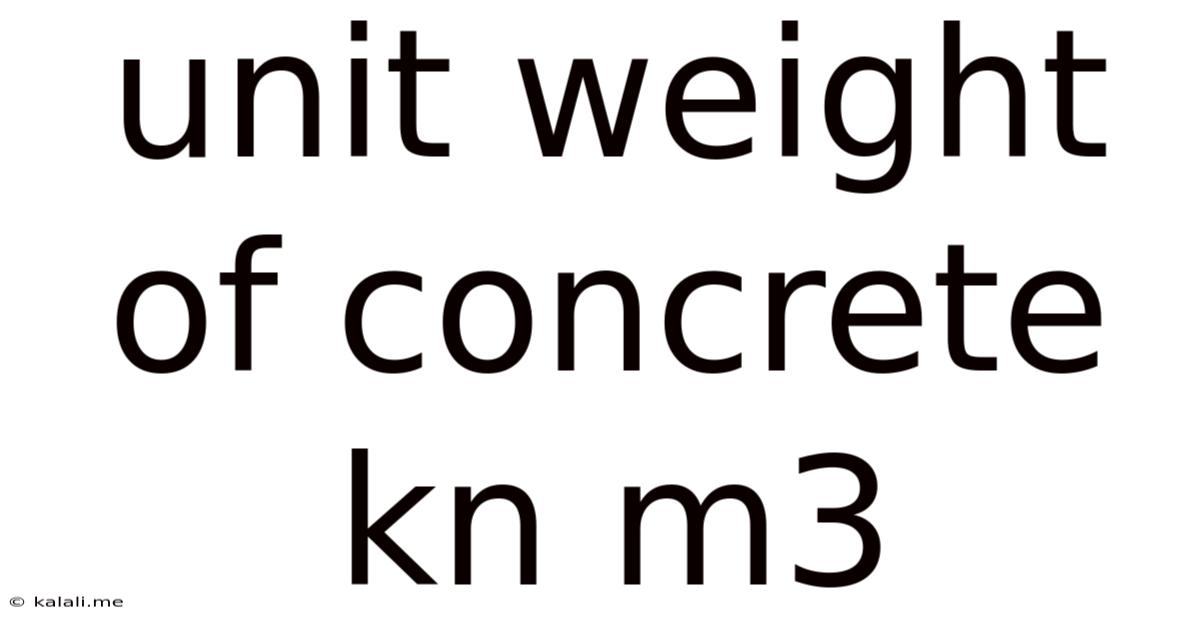Unit Weight Of Concrete Kn M3
Kalali
Jun 11, 2025 · 3 min read

Table of Contents
Unit Weight of Concrete: A Comprehensive Guide (kN/m³)
Knowing the unit weight of concrete is crucial for various aspects of construction, from structural design calculations to estimating material quantities. This comprehensive guide delves into the factors influencing concrete's unit weight, provides typical values, and explains its importance in different applications. Understanding this seemingly simple concept can significantly impact the safety and efficiency of your projects.
What is Unit Weight of Concrete?
The unit weight of concrete, often expressed in kilonewtons per cubic meter (kN/m³), represents the weight of a cubic meter of concrete. This is a critical parameter in structural engineering, as it directly impacts the load-bearing capacity of concrete structures and influences the design of foundations, beams, columns, and other structural elements. Understanding this value allows engineers and contractors to accurately estimate material quantities, calculate stresses, and ensure structural integrity.
Factors Affecting Concrete Unit Weight
Several factors influence the unit weight of concrete, leading to variations in its value. These include:
-
Concrete Mix Design: The proportions of cement, aggregates (sand and gravel), and water significantly affect the density and, consequently, the unit weight. A higher cement content generally leads to a higher unit weight. The type and grading of aggregates also play a crucial role.
-
Water Content: Excessive water in the concrete mix reduces the density, resulting in a lower unit weight. Proper water-cement ratio control is essential to achieve the desired strength and unit weight.
-
Type of Aggregate: The specific gravity of the aggregates used (e.g., crushed stone, gravel, recycled aggregates) directly impacts the overall density of the concrete. Heavier aggregates will result in a higher unit weight.
-
Air Entrainment: Introducing air into the concrete mix (air entrainment) reduces the unit weight. While air entrainment improves durability by increasing resistance to freeze-thaw cycles, it lowers the overall density.
-
Curing: While curing doesn't directly change the initial unit weight, inadequate curing can lead to shrinkage and potential cracking, indirectly affecting the effective unit weight of the hardened concrete over time.
Typical Unit Weight Values
The unit weight of concrete typically ranges from 22 kN/m³ to 25 kN/m³. However, it's essential to note that this is an approximation, and the actual unit weight can vary considerably depending on the factors mentioned above. For precise calculations, always refer to laboratory test results specific to the concrete mix being used in a particular project. Using a conservative estimate on the higher end of the range is generally recommended for structural design to ensure adequate safety margins.
Importance in Construction and Engineering
Accurate determination of the unit weight of concrete is vital for several reasons:
-
Structural Design: It's a fundamental input in structural analysis and design calculations, influencing the determination of stresses, deflections, and overall structural stability.
-
Load Calculations: Accurate unit weight is essential for calculating the dead load of concrete structures, which significantly impacts the overall design loads.
-
Material Estimation: Knowing the unit weight allows for precise estimation of the quantity of concrete required for a project, minimizing waste and optimizing material costs.
-
Foundation Design: The unit weight directly influences the design of foundations, ensuring they can adequately support the weight of the structure.
Conclusion:
The unit weight of concrete is a critical parameter in construction and engineering. Understanding the factors that influence it and using accurate values in calculations are crucial for ensuring the safety, stability, and cost-effectiveness of any concrete structure. Always consult relevant codes and standards, and ideally, obtain laboratory test data for the specific concrete mix being used, to achieve the most accurate results and ensure a successful project. Remember to account for potential variations and always err on the side of caution when making estimations for structural design purposes.
Latest Posts
Latest Posts
-
How Many Cups Is 12 Oz Of Chocolate Chips
Jul 01, 2025
-
How Do You Beat Level 7 On Bloxorz
Jul 01, 2025
-
What Grade Level Do You Learn Algebra 1
Jul 01, 2025
-
How Long Ago Was The 16th Century
Jul 01, 2025
-
How Many Inches Are In 4 Yards
Jul 01, 2025
Related Post
Thank you for visiting our website which covers about Unit Weight Of Concrete Kn M3 . We hope the information provided has been useful to you. Feel free to contact us if you have any questions or need further assistance. See you next time and don't miss to bookmark.